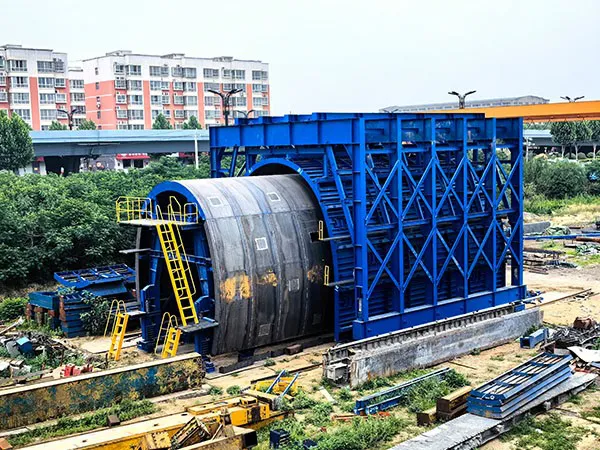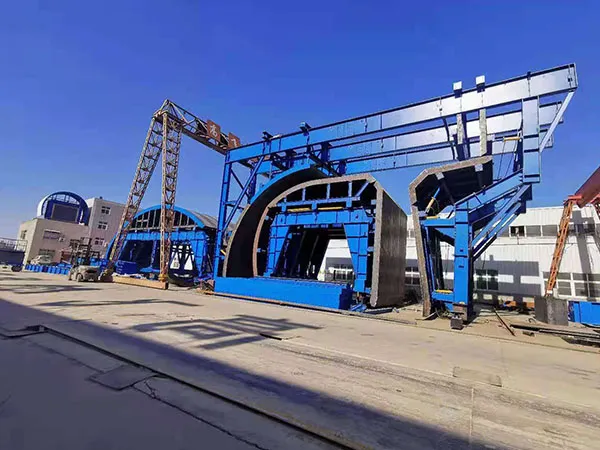Choosing the appropriate motor power for a tunnel lining trolley is crucial for efficient and safe operation. It involves considering various factors related to the trolley's function, the tunnel's characteristics, and the concrete lining process.

A tunnel lining trolley typically performs several tasks, each requiring specific power:
Traveling/Movement: This is the primary function. The motor needs to overcome:
Rolling resistance: Friction between the wheels and the tracks.
Grade resistance: If the tunnel has an incline (crawling ability).
Acceleration torque: The force needed to start and increase the speed of the trolley.
Total weight of the trolley: This includes the steel formwork, hydraulic system, concrete if present during movement (though usually it's poured after positioning), and any auxiliary equipment or personnel.
Short-distance movement: For precise positioning, motors need to provide accurate control.
Hydraulic System Operation: Most modern lining trolleys use hydraulic cylinders for various operations:
Lifting and lowering the formwork: This involves overcoming the weight of the formwork and the concrete pressure during pouring.
Opening and closing side templates: For demolding and adjustment.
Horizontal and vertical adjustments: For precise alignment.
Vibrating concrete: Some trolleys have attached vibrators to ensure proper concrete compaction. The hydraulic pump motor needs sufficient power to drive these cylinders and vibrators.
Auxiliary Functions:
Lighting: For visibility within the tunnel.
Control systems: Power for the electrical and electronic components.

Trolley Specifications:
Length and weight of the trolley: Longer and heavier trolleys require more power for movement and lifting.
Maximum lining length per unit: This indicates the scale of the operation.
Walking speed: The desired speed of movement impacts the power required, especially for acceleration. Common walking speeds are around 8m/min.
Crawling ability (gradeability): If the tunnel has an incline, the motor must be powerful enough to overcome the upward force of gravity. A typical crawling ability might be 4%.
Tunnel Characteristics:
Tunnel geometry: Straight vs. curved tunnels, variations in cross-section.
Ground conditions: Affects track laying and potential for resistance during movement.
Concrete Properties and Pouring Method:
Concrete density and slump: Heavier or stiffer concrete may exert more pressure on the formwork, impacting hydraulic system power.
Pouring speed: Faster pouring might require more robust hydraulic systems.
Operational Requirements:
Duty cycle: How frequently and for how long the motors will be operating. Continuous operation requires higher rated motors to prevent overheating.
Starting torque: The motor needs to provide enough torque to overcome static friction and accelerate the trolley from rest.
Safety factors: Always incorporate a safety margin to account for unforeseen loads, wear and tear, and potential overloads.
Power Supply:
Voltage and current availability: The motor must be compatible with the available power supply in the tunnel.
Efficiency of the electrical and hydraulic systems: Inefficient systems will require more input power for the same output.
While specific calculations can be complex and are often done by manufacturers, the general approach involves:
Calculating individual power requirements:
For movement: Calculate the force needed to overcome rolling resistance, grade resistance, and acceleration. Then, use P=F×v (Power = Force x Velocity) for linear motion, or P=T×ω (Power = Torque x Angular Velocity) for rotational motion, ensuring consistent units.
For hydraulic pump: Determine the required hydraulic pressure and flow rate for all hydraulic cylinders. The power for the pump motor can be calculated based on these values and the pump's efficiency.
Summing up the power requirements: Add the power needed for each primary function (movement, hydraulic pump, etc.).
Applying a safety factor: Multiply the total calculated power by a safety factor (e.g., 1.2 to 1.5) to account for losses, varying conditions, and peak loads.
Considering motor efficiency: The output power of the motor will be less than the input electrical power due to efficiency losses. Ensure the selected motor's rated power is sufficient for the required output mechanical power.

One example cited a tunnel lining trolley with:
Traveling motor: 7.5KW * 2 = 15KW (indicating two motors for movement)
Oil pump motor: 7.5KW
Total power: 22.5KW
This suggests that for a typical tunnel lining trolley, a total power in the range of 15-25kW might be common, with a significant portion dedicated to the traveling mechanism and the hydraulic system.
Recommendations for Choosing Motor Power:
Consult with Manufacturers: The most reliable way to select motor power is to provide your specific project details (tunnel dimensions, trolley weight, desired speeds, concrete volume, etc.) to tunnel lining trolley manufacturers. They have specialized knowledge and can perform detailed calculations and recommend suitable equipment.
Review Technical Specifications: Look for detailed technical parameters of existing trolleys that match your project's scale.
Consider Modularity: Some trolleys may have separate motors for different functions (e.g., dedicated motors for travel, and a separate motor for the hydraulic pump), allowing for optimized power distribution.
Future-Proofing: Consider potential future needs or changes in project scope that might require slightly more power.
Energy Efficiency: Choose motors with good energy efficiency to reduce operating costs.
By carefully considering these factors and consulting with experienced professionals, you can ensure the selection of appropriate motor power for your tunnel lining trolley, leading to efficient, safe, and reliable tunnel construction.
Gaofei
Address: 200m east of tulip garden, group 12 of zhangling community, hongshan street office, hongshan town, xigong district, Luoyang
Tel: +8616638856888
Contact: Gaofei Huang
Mobile: +86-18637923976
Phone: 0379-80881719/ 0379-60162687
QQ: 286827457
E-mail: gaofei@gf-bridge-tunnel.com